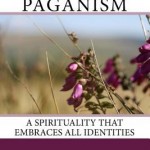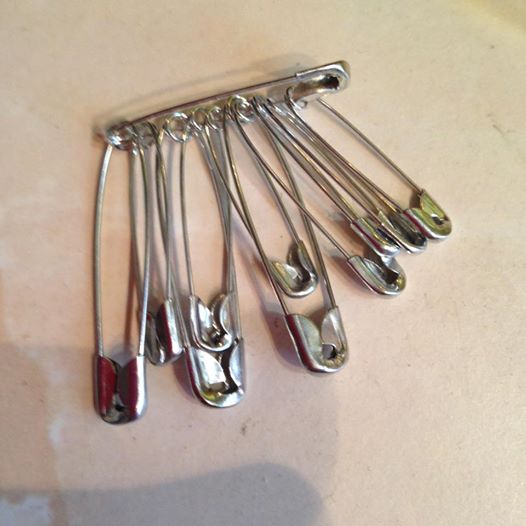Gender is a difficult concept. I literally have no idea why some activities, clothing styles, thoughts, and behaviours are labelled “masculine” and others are labelled “feminine”. It all seems very arbitrary to me. In some languages, objects are assigned a grammatical gender. The designation of assertiveness as a “masculine” trait, or receptiveness as a “feminine” trait, seems just as arbitrary to me as saying that a car is “masculine” and a table is “feminine”.
Initially I found the concept of a spectrum of gender and sexuality quite helpful as a tool to think with, but even that reinforces the idea of a binary, and treats the concepts of biology, identity, and expression as distinct and essential traits which can be classified as “masculine” or “feminine”. I just read a critique of the genderbread person which explains very effectively what’s wrong with thinking about gender as a spectrum: it assumes that “male” and “female” are at opposite ends of the spectrum, and that genderqueer is somewhere in the middle. You could also have a spectrum from zero gender to 100% gender – but all of these are meaningless unless you accept that personality traits are somehow gendered (which I don’t). Certainly personality traits are often regarded as being associated with a particular gender, but they are not essentially or inherently gendered. Here’s an identity-bread person and a GSM diagram which doesn’t present identity or anything else as a spectrum (my only criticism would be that the line for sexual attraction points to genitalia, and I am attracted to the whole person, not just what they’ve got in their pants). Gender is more of a random scatter plot than a spectrum. So I apologise if my previous efforts to describe gender as a spectrum were actually reinforcing a cisnormative model.

Social Constructs
The thing is that both biological sex and gender identity are social constructs. However, a social construct can have real effects and correlates in the way the world is constructed. Consider the effects of dividing toilets up into toilets for people designated male and toilets for people designated female, for example.
Our society arbitrarily assigns gender at birth based on physical characteristics (usually, having a penis or a vagina). If a child’s genitalia are different, the medical establishment reconstructs them to be more like either a penis or a vagina, and the child is then assigned a gender based on the modified genitalia. A person who accepts the gender they were assigned at birth, and who lives according to the social expectations attached to their assigned gender, is cisgender. A person who does not accept the gender they were assigned at birth, and does not live according to the social expectations attached to their assigned gender, is transgender. Some transgender people want to be the other side of the gender binary. Many transgender people are genderqueer, non-binary, genderfluid, metagender, etc. (The “etc” at the end of that list is not meant to be dismissive of other identities, but inclusive of them.)
How gender is socially constructed
As a child grows up, they are treated differently based on their assigned and perceived gender, both by their families and society in general. Parents who have tried to break out of this binary by giving their child a gender-neutral name and not revealing the gender on the child’s birth certificate have had varying degrees of success, due to lack of co-operation from people around them.
I was fortunate in that, although I was assigned female at birth and raised as a girl, my parents encouraged me to choose hobbies and interests and clothing based on my preferences, rather than because of my assigned gender. I have also spent most of my life hanging out with people who don’t conform to gender stereotypes.
I was a bit surprised when I joined the lesbian society at my first university in the late 1980s and found it included many lesbian separatists. I suspect they frowned on my bisexuality. I asked why we didn’t hang out with the gay society. “They’re still men” was the reply. Nowadays every university has a LGBT society, thank goodness.
Gender essentialism in the Pagan movement
When I first got involved in Pagan groups (in the late eighties and early nineties), I remember discussions about whether there were gender stereotypes in the kinds of magical or Pagan groups people chose. Perhaps Wicca was a “girls’ subject” and chaos magic was a “boys’ subject”? (The people who were asking these questions wanted to do away with these gender stereotypes.)
Then I started reading second-wave feminist books, many of which were gender-essentialist. Women were nurturing and peaceful, according to these books, whereas men were warlike and aggressive. I didn’t really buy into these stereotypes, but they were insidious because there were a lot of them about.
In the 1990s, people started organising women’s circles and men’s circles within Pagan groups. (Maybe they existed before this in some groups, but in Wicca, I think it started around the mid-nineties.) To my eternal shame, for a short time (maybe six months) I was one of the people who wanted to deny trans women access to women-only circles. I am totally embarrassed about this now, but I mention it as evidence that people can change.
Around this time I also encountered people who made claims like “you’re not a real woman unless you have given birth”. This is easily dismissed by the fact that many trans men have given birth, and many cisgender women haven’t. Many people who have spent a lot of time in gender-essentialist women’s circles report that women who have given birth get extra kudos in these circles, and even more kudos if they gave birth to a girl. This sort of attitude has always seemed to me to be the mirror image of the kind of extreme patriarchy which only values women as potential carriers for sons.
At the same time, because I don’t see gender as being an “essence”, I was worried that the existence of transgender people made the distinction between male and female a hard boundary that could be crossed by a change in physical characteristics, rather than a fuzzy boundary that could eventually be abolished. Thinking of both gender and biology as a spectrum (from masculine to feminine, and from male-bodied to female-bodied) helped me to get over that worry. I reasoned that a person who is physically at one end of the spectrum but mentally at the other would naturally want their physical characteristics to match their gender identity. I accept now that this is still overly binary, but it helped me to get my head around it. If people have still got their ideas firmly attached to the notion of a gender binary, shifting them to the concept of a spectrum is still an improvement on a dualistic binary. We are also up against a huge backlash from people who actually think that the gender binary is real, so things like thinking of gender and sex as a spectrum are what we might call “baby steps” in moving away from binary thinking on this. But we still have to remember that it is only a model.
Energy doesn’t have a gender
Another deeply entrenched concept in many Pagan groups is the concept of “male energy” and “female energy”. Personally, whilst I have been able to experience energy, I have never experienced it as gendered. I have found that energy can be created in a variety of ways with different people. We could label these ways polarity (making energy with someone based on the tension of opposites), resonance (making energy with someone based on the alignment of similarity), and synergy (bringing the energies of a group of people together) – but I think this is probably too simplistic as well. Sometimes the creation of energy relies on erotic tension (which could occur between any two people); sometimes it is created by friendship, or trust, or just the coming together of two or more people and a moment of openness between or among them. The problem is that we as a species like to label and categorise – it is how our brains work. Problems occur when we forget that the map is not the territory.
I don’t think sexual and social attraction has as much to do with gender as people think, either. For me, attraction is based on a person’s competence and confidence and integrity, as well as physical attraction (and a person doesn’t have to be conventionally good-looking for me to find them attractive).
Polarity can definitely be made in other ways than the coming together of a male-assigned person and a female-assigned person. At Witchfest 2015, I ran a workshop/ritual on gender and sexuality, and I mentioned various pairings that could make polarity: morning people and evening people, tea-drinkers and coffee-drinkers, people who love Marmite and people who don’t. The one that got the biggest reaction was the mention of Marmite, so that was the one we chose for the ritual. The room divided up into people who liked Marmite, and a group of people who didn’t. We decided they needed something nice to focus on, rather than hating Marmite, so they chose chocolate. A few people defected from the Marmite group to the chocolate group at this point (splitters!). The Marmite group focussed on the yumminess of Marmite on toast with butter, and the chocolate group focussed on the yumminess of chocolate. During the whole focussing session, a car alarm was going off in the car park. As soon as we brought the polarised energies together, the car alarm stopped. We sent the energy raised in the ritual to empower trans people, as it was around the time of the Transgender Rite of Elevation and Transgender Day of Remembrance.
There are many polarities (spirit and matter, inner and outer, life and death being among those we might consider “ultimate” in some way) but it is not particularly helpful to think of “male” and “female” as being opposites, nor as ultimate or cosmic. It certainly isn’t helpful to think of them as being mutually exclusive, or essentially constituted in a particular way. It may be useful to think about yin and yang instead, as long as you don’t think of them being essentially masculine or feminine, but rather more like hot and cold, or expansive and contracting. The thing is that one person may be more yang than another person, but less yang than a third person; so they are yang in relation to the first person, but yin in relation to the second person. Further, this can vary on any given day and in any given situation. It is not a fixed characteristic. Some days, you might be in the mood for Marmite and butter on toast; other days, you might really want chocolate. But there are people who always prefer chocolate, and others who always prefer Marmite.
“Women-only” groups
It is understandable that sometimes, people would want to come together on the basis of shared experience, such as having given birth, menstruating, or the menopause. But to then claim that these experiences somehow represent the essence of “femaleness” or of what it means to be a woman, is to reduce identity to biology. Trans men and genderqueer people can also menstruate and give birth.
I don’t quite understand the need to only talk about menstruation in front of other people who menstruate, or have menstruated. For various misogynistic reasons, menstruation is regarded as taboo in our society – so wouldn’t it be better to break down that taboo by talking about menstruation with everyone, rather than only among people who menstruate? I guess we might need to talk about it in menstruating-people-only spaces to start with, to help break down our internalised taboos about it, but after that, why not talk about it openly? (I suppose the not-menstruating people might feel excluded, but only if it is talked about in an excluding way.)
The same applies to talking about giving birth. I have experienced this kind of talk as excluding when it veers towards “you’re only a real woman if you’ve given birth” but I don’t mind if people want to talk about it. I do mind if they get all superior about it. Not having done it myself, I can’t contribute much to the conversation, but it’s OK.
Another excuse for cisgender-women-only groups is often that they are safe spaces for rape survivors, and that a rape survivor may be re-traumatised if she sees a woman with a penis. The people making these claims tend to forget that LGBTI people, including trans women, may also be survivors of sexual violence. And most women with a penis are aware that other people may be confused by their penis. Here are some helpful suggestions from Zinnia Jones for what to do with your penis if you are in that category. She writes:
People like to assume that our bodies are still essentially men’s bodies, and therefore work the same way. However, as any trans woman can tell you, this just isn’t the case. From social situations to sex to surgery, the standard dudely dick dilemmas simply aren’t all that relevant to our lives. So, for the sake of my fellow trans ladies (but mostly for any confused cis onlookers), I’ve assembled my own 10 semi-serious tips for wrangling a girl penis.
Take particular note of points 7 and 8: if a trans woman is taking oestrogen, then it is very difficult to get an erection.
The truth is that running estrogen on unlicensed hardware can scramble almost every aspect of sexual response. Things just don’t work the way they used to: orgasms change or disappear, your whole body reacts to touch in different ways, and the entire structure of arousal-erection-climax may break down. Traditional techniques might not cut it any more, and new approaches can be non-obvious.
So a trans woman with a penis is quite literally not a threat. I can understand rape survivors not wanting to see any penises at all during the immediate aftermath of the rape, and that the trauma could last for a long time, but I doubt that it would last for the rest of one’s life.
Another key point in all of this is that if you want to create a group or a ritual that is only for a particular category of people, try to do it in a non-essentialist way. Many marginalised and oppressed groups want to create a space for empowerment (people of colour, LGBTQIA people, and women, among others) but if you create these spaces in a public setting in a way that marginalises another oppressed group, then that is oppressive. If you want to create a ritual for people who menstruate, that seems reasonable, but don’t insist that only people who menstruate are women, or that all people who menstruate are women, because that is essentialist. I menstruate; I am genderqueer.
And if you do a rebirthing ritual (where people crawl between the legs of other people in a symbolic rebirth), have everyone in the group crawl between everyone else’s legs, regardless of gender.
Gender identity
What about the people who do identify as male or female? Good for them. No-one is stopping them from doing so, but it would be better if they acknowledge that other genders are available, and that your genitalia and socialisation process do not determine your gender. However, even cisgender identity is fluid and changeable, and not fixed to a specific mode of being or social interaction, so don’t assume that a masculine-looking person automatically likes stereotypically “masculine” pastimes and topics of conversation, or that a feminine-looking person wouldn’t be interested in them.
Since gender is all a bit of a mystery to me, I am happy to use whatever pronoun anyone prefers for their gender identity. (But as a grammar nerd, I do want to know how to use it in all grammatical contexts. And yes, you can use ‘they’ as a singular word; people have been doing so to refer to an unknown person of unknown gender for decades; and pronouns have often changed from singular to plural and back again, as in the use of Sie in German to mean they plural and the polite form of you singular; and the use of vous in French to mean you in both the singular and plural forms; and you in English to mean both singular and plural. Anyone claiming to be a grammar nerd should know this; so anyone claiming to be unable to use singular ‘they’ for reasons of grammar nerdiness is just a bigot.)
Some sort of conclusion
I guess some sort of conclusion is expected at this point. I guess what I am trying to say is, can we all listen to and respect each other’s unique experiences and identities, and not put them in some grand overarching category? Categories are only useful insofar as they help us to find other people with similar experiences, and help us to communicate our experiences and intersecting identities to other people using a word or phrase; beyond that, they are confining and constricting. The more we regard categories as monolithic and unchanging, and somehow representing an essence, the harder it is to see the individual person and their lived experience. In short, can’t we all be nice to each other for a change?
















